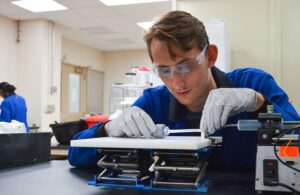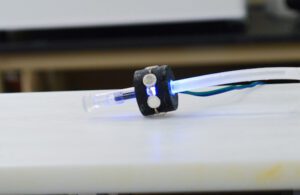
Matthew Hausladen working with a new soft robot technology that could have use as a medical device and in manufacturing. [Photo courtesy of the University of Minnesota]
University of Minnesota scientists and engineers have taken a page from plant growth for new soft robot technology that might be able to navigate hard-to-reach places within the human body.
Some forms of soft robots — made of soft, pliable materials versus more traditional rigid materials — create new materials to grow and move, usually applying heat and/or pressure to solid material to grow themselves.
The University of Minnesota’s new extrusion process enables a soft robot to propel itself with newly grown material. It uses liquid resin and ultraviolet light to make and push synthetic material out of itself, the team said. The Proceedings of the National Academy of Sciences of the United States of America (PNAS) published their paper.
“We were really inspired by how plants and fungi grow,” first author Matthew Hausladen said in a news release. “We took the idea that plants and fungi add material at the end of their bodies, either at their root tips or at their new shoots, and we translated that to an engineering system.”
More about the University of Minnesota soft robot tech

This soft robot grows and moves using a new process called extrusion by self-lubricated interface photopolymerization, or E-SLIP. [Photo courtesy of the University of Minnesota]
The name of the new process is extrusion by self-lubricated interface photopolymerization (E-SLIP). Using E-SLIP, the new tip-growing soft robot grows up to 1.5 m long at speeds of up to 12 cm/min.
It’s the first time that researchers have demonstrated the concept, according to lead author Chris Ellison. Ellison is the Zsolt Rumy innovation chair in the University of Minnesota Twin Cities Department of Chemical Engineering and Materials Science.
“Developing new ways of manufacturing are paramount for the competitiveness of our country and for bringing new products to people,” Ellison said in the release. “On the robotic side, robots are being used more and more in dangerous, remote environments, and these are the kinds of areas where this work could have an impact.”
The light-and-liquid extrusion process could also have applications in manufacturing. For example, it could potentially replace processes that make or shape material using heat, pressure and expensive equipment.
Hausladen, a Ph.D. student in the University of Minnesota Twin Cities Department of Chemical Engineering and Materials Science, explains and shows how the soft robot works in the video below.
The National Science Foundation funded the research, details of which can be found in the paper published in PNAS.